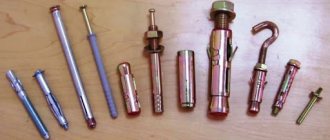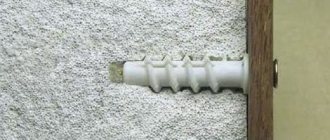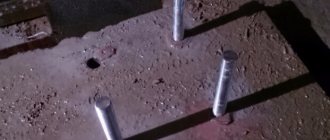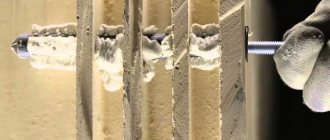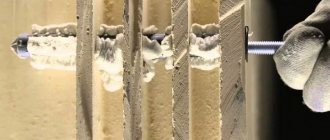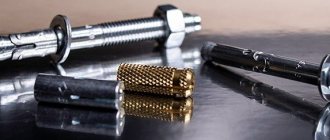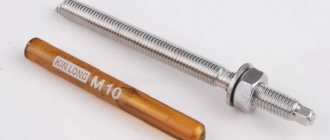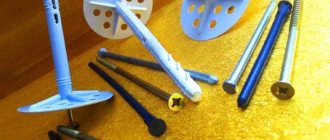Beton-House.com
Website about concrete: construction, characteristics, design. We combine the experience of professionals and private craftsmen in one place
Testing the strength of an anchor installed in cellular concrete
Cellular concrete is increasingly becoming part of our everyday life, replacing many block materials in low-rise private and mass construction. There are many reasons for this, ranging from reasonable cost to excellent thermal insulation properties.
However, this material has one significant drawback - it is fragile and cannot cope with any serious loads. This applies primarily to low-density blocks, which are used for insulation.
For this trivial reason, many are puzzled by the question of how to install mounted equipment on such walls. Today we will analyze mechanical and chemical anchors for aerated concrete - look at their varieties and basic properties.
Fastening building structures to aerated concrete
On such fragile walls it is necessary to fix not only wires and pipes, but also heavy structures: floors, roofing elements, etc.
In such cases, fixing self-tapping screws into aerated concrete is not a solution; a serious decision is needed. As a rule, it is carried out during the process of laying walls, when a monolithic reinforced concrete armored belt is made at the installation level of such structures. During pouring, studs and other embedded parts are installed into it, onto which the fastening is subsequently carried out.
If for some reason you did not make an armored belt, or did not provide mortgages in it, fastening is carried out only with chemical anchors.
Features of fastening to an aerated concrete block
Due to their porosity, aerated concrete walls are quite fragile, as a result of which fastening anything becomes difficult or even impossible. In this case, fastening occurs using a dowel. First, the hole is prepared - a hole is drilled to fit the dimensions of the fastener. Then the dowel is inserted and a screw is screwed into it or a nail is driven into it, which leads to the expansion of the dowel inside the hole. After this, removing the dowel without damaging a large section of the wall is already problematic.
As you can see in the picture, the screwed dowel is firmly fixed inside and does not allow the screw to be pulled out of the hole.
When choosing fastenings for aerated concrete walls, take into account such features
When choosing hardware, take into account the strength of the working surface, the dimensions of the parts and their resistance to corrosion.
The higher the density of the material, the stronger the aerated concrete. This indicator sets the load limits on the fastener. Technical characteristics in digital terms are indicated on the packaging of building blocks after the letter D.
The strength of the connection is affected by the size of the dowels. Thus, when fixing massive structures, products of large diameters and lengths are used.
The resistance of fasteners to corrosion ensures the possibility of their use when installing external structures and arranging unheated premises.
Selection requirements
Fastening elements for aerated concrete blocks must meet the following requirements:
- The density of aerated concrete must correspond to the characteristics of the fasteners.
- The length and load-bearing capacity of fastening elements should be selected based on the static load on the gas block when installing furniture.
- The corrosion properties of fasteners must correspond to the conditions in which the house is planned to be used.
Under no circumstances should you make a hole for a dowel by gouging it out, since only by drilling can the strength properties of the material be preserved.
Scope of application
Chemical anchors in aerated concrete are used less frequently. It is used in cases where it is necessary to provide reliable fastening for massive objects. Mechanical anchors are not capable of supporting, for example, the weight of massive equipment.
Epoxy compounds are used mainly on solid bases. They are used for fastening:
- wall structures;
- beams;
- fences along roads;
- creating noise-insulating screens;
- when installing reinforcement outlets;
- when installing attachments.
This composition can be used:
- in a humid environment;
- under the water;
- both outside the building and for interior work.
Its composition:
- does not create stress in the structure of the porous wall;
- does not contain styrene;
- creates fastenings with smooth reinforcement.
The hardening of the mass depends on the air temperature. The time can last from 7-180 minutes. or 7-48 hours.
Polyester anchors are used to create:
- enclosing structures;
- when installing façade elements;
- for installation of translucent elements;
- during installation of utilities.
Typically, threaded rods are installed along with polyester compounds. The polyester anchor does not contain styrene. Therefore, it can be used on interior and exterior fasteners. The polyester anchor takes from 2 to 30 minutes to set and hardens from 25 to 180 minutes.
The anchor bolt for aerated concrete can be smooth or threaded if a vinylester anchor is used. It is used to create fasteners in wet substrates. It does not create unnecessary stress in the structure of aerated concrete. This adhesive solution is safe because it does not contain harmful substances. It is used for making internal and external fasteners. Does not create stress after installing fasteners in the structure of the aerated concrete block. Hardening is observed after 15 minutes or a day.
Epoxy acrylate anchor composition has become more widely used due to its properties. The period of setting and hardening of the composition is 2-24 and 15-180 minutes, respectively. Epoxy acrylate retains its properties when the temperature drops to -5°C, and also resists fire in case of fire for up to 2 hours. Epoxy acrylate anchor composition is suitable for anchoring floor slabs in aerated concrete houses.
Features of application
To install a mechanical sleeve in aerated concrete, you must follow the following rules:
- The drilled hole is cleaned of dust for better fixation.
- The depth of the hole must be greater than the fastener. The spacer will open properly if part of the screw remains outside.
When installing chemical anchors for aerated concrete, the prepared hole is filled ¾ with glue, otherwise it will come out when the steel rod is inserted. If you do not first clean the hole from dust and debris, the adhesive will not work. The hardening time of the glue depends on its composition, temperature and humidity of the environment and ranges from 2-15 minutes to 12-24 hours.
Why you shouldn’t attach excessively heavy structures to gas block and foam block
About the gas block
Autoclaved aerated concrete has thermal conductivity characteristics close to foam plastic because, like insulation, it contains air bubbles in its structure. At the same time, foam plastic has almost zero load-bearing capacity.
Why should a gas block be so much more durable? It should be noted that it copes well with a load evenly distributed over an area, for example, in wall masonry. But it does not tolerate local loads from ordinary dowels and anchors, that is, it simply does not hold
And no matter what the manufacturers of such blocks say, you need to load the material locally with great care - use special fasteners, spread them over a large area, do not hang very heavy structures without a metal frame
Excessive load on aerated concrete can lead to similar consequences
The weakest point of an aerated block in terms of load-bearing capacity is variable pressure. Periodically attaching and removing any heavy structure from an anchor will contribute to the crumbling of the material around the fastener and failure of the attachment point.
About the foam block
Foam concrete is used less frequently in modern construction, and on average it is heavier and stronger than aerated concrete. Of course, strength depends on the class of the material - the higher the class, the more durable it is, but at the same time it loses somewhat in its heat-insulating properties.
Perhaps we can say that the foam block is somewhere between concrete and aerated concrete in terms of strength. However, when choosing an anchor for foam concrete, it is better to be guided by the same principles that apply when using aerated concrete.
Characteristic
Aerated concrete is rightfully recognized as one of the most practical and affordable materials. It makes durable and strong houses, as well as reliable outbuildings. However, you need to take into account that this material has a cellular structure, when faced with which you need to take into account many nuances. The main characteristic feature of this material is its fragility and pliability. Porous blocks can be trimmed or cut off the excess part without any extra effort. And we must also not forget that special fasteners are used for such a structure. Traditional fasteners, as a rule, do not adhere well to such foundations, which is why the whole point of their use is lost.
For aerated concrete, special dowels should be used. The design of such parts is a sleeve in the form of a spiral, on the surface of which there are ribs. When screwing in a self-tapping screw, the last elements become wider, so they fit firmly into the loose aerated concrete surface. This simple but effective device can easily withstand impressive loads. With the use of special dowels, home owners have the opportunity to hang heavy decorative objects of any size on the walls.
Modern manufacturers produce these types of dowels in two variations. They differ in design features.
- According to the shape of the fixation ribs. Such fasteners can be equipped with a classic helical spiral or have cone-shaped ribs. The edges of the latter may resemble spiral-like blades.
- By installation method. The dowels are either screwed into the base or driven into it. Screw-in types are considered to be the most reliable. It is recommended to use driven-in fasteners if the aerated concrete floor is planned to be equipped with a collet.
Fastening building structures to aerated concrete
In general, the process of installing fasteners is similar for all options. First of all, a hole is made, and then the cartridge is inserted. The only difference can be with a chemical anchor, since it uses glue.
Chemical anchors are secured as follows:
- Preparatory work. You need to drill a hole using a drill.
- Next, the hole needs to be cleaned of dust. To do this, use a brush or a medical bulb.
- A cartridge with a chemical composition is installed. To do this, you need to insert a capsule with glue into the recess. The last one is squeezed out.
- An anchor is screwed into the hole.
- You need to wait until the glue dries. There are times when you need to wait 2 days for complete drying. It all depends on the composition, but temperature, humidity and other environmental features are also considered important factors.
- Once the compound has hardened, you can install the washer and nut.
The installation process using a mechanical anchor, dowel nail or self-tapping screw is the same, but without the use of glue.
This is what the fastening looks like inside aerated concrete.
Video on the topic:
Each fastening method has its own advantages and disadvantages. When choosing, you should take into account the material, density, and characteristics of the room.
Previous entry How to attach a window sill to a plastic window Next entry Features of attaching gates to brick pillars
Work order
- Preparatory work - a hole is drilled using a drill.
- The planting recess is cleaned of dust; it is recommended to use a small brush or a medical bulb.
- Installation of a cartridge with a chemical composition. A capsule with adhesive mass is inserted into the hole or the glue is squeezed out of the tube.
- The anchor rod is screwed into the hole.
- It happens that for the adhesive solution to completely harden you will need to wait 48 hours. In addition to the composition of the glue, the duration of hardening is affected by the ambient temperature and other environmental factors.
- After the composition has hardened, install the nut and washer.
Installation of the fastener can be easily done by hand without the involvement of a qualified technician. Depending on the purpose, metal products that have anti-corrosion coatings and polymer agents are used.
Adhesive mixtures based on polystyrene resins also do not contain styrene; they can be used for installation outside and inside.
Glue made on the basis of epoxy resin is a popular means for installing anchor bolts in aerated concrete blocks, class above C20-25. In addition to reinforcing bars, fasteners are common in the following installation areas:
- various elements on the surfaces of walls, beams and road fences, which are made of concrete;
- screens that perform noise insulation functions;
- various technological units.
Dowel
The part is a spiral-shaped bushing with ribs on the surface. At the moment the screw is screwed in, they expand, due to which they firmly fit into the soft surface of the base. Such fasteners can be made of galvanized steel or plastic.
The first option is the most common and is considered the most expensive. It is used when installing profiles, installing attachments and furniture, and fixing various pipelines. Such fasteners have become widespread in fire-hazardous spaces.
Metal dowels for aerated concrete are produced in 2 modifications, which differ in design features and installation methods. The parts can either be screwed into the base or driven into it. The latter option is used if the aerated concrete floor is planned to be equipped with a collet.
Based on the shape of the fixation ribs, fasteners with a classic helical spiral and dowels in the form of a cone, equipped with spiral blades, are distinguished. The design of metal elements also provides for the presence of a locking flange or cuff, thanks to which the part will not rotate.
Corrosion resistance is the main advantage of plastic products. The materials used for them are polypropylene and polyethylene. The positive characteristics of the parts include their efficiency, environmental friendliness, and immunity to aggressive environments. Such dowels are not intended for outdoor work, since with the onset of cold weather the plastic may burst.
A separate group consists of fasteners for aerated concrete made of nylon. They are more wear-resistant, so they can be used for cladding facades. Together with them, galvanized screw elements with 2 types of heads are used - countersunk or hexagonal. The disadvantage of this type of fastening is the high price.
Depending on the scope of application, there are several types of dowels:
- Universal. It can be mounted in any concrete surface. In a solid base, fixation occurs in a standard way. In a cellular coating, the product is rolled into a persistent knot. However, the load-bearing capacity of universal dowels is lower than that of spacer elements.
- A dowel-nail that has a wide range of applications. At the moment of fixation, a nail is inserted into the fastener, rather than a screw being screwed in. In order to avoid turning the part, use a sleeve.
- The “pancake-like” structure of the frame dowels allows you to reduce the load on the porous surface of the block.
Tool and surface features
Installation tools:
- electric hand drill;
- drill bit with pobedite tip;
- hammer;
- a wrench or screwdriver for screwing in a screw;
- adhesive mixture for chemical anchor;
- special gun for glue mixture.
The main condition when installing objects and accessories is the correct choice of hardware.
Aerated concrete, having a porous structure, is a relatively fragile material, so the question arises - what kind of hardware is needed to ensure that the fastening is reliable and meets all the operating requirements of the structure.
There is a wide range of products that make it possible to fasten structures reliably and quickly.
From the video below you will learn about fasteners for aerated concrete.
The mounting anchor and installation method will depend on the future load
- when installing suspended shelves in aerated concrete, you must make a hole at an angle of 90 degrees and insert a dowel into which a screw is then screwed;
- If the task is to hang a light picture or install an electrical switch, it will be enough to use an ordinary self-tapping screw. Screwing should be done at an angle of 45 degrees to the partition.
To securely fasten heavy units or install massive metal doors, it is recommended to use chemical anchors. These are special capsules consisting of synthetic resins and organic polymers that can monolith a hole in a partition made of gas blocks and firmly hold a metal rod and threaded part in the structure.
Mechanical anchor
Mechanical anchors for aerated concrete blocks are called “butterflies”, this is explained by the peculiarity of their design. The edges of the fasteners that will be mounted in the holes are split into pieces when the anchor screw is screwed in; as a result, the anchor takes on the shape of a butterfly. With this method, a good fixation is obtained in a pre-drilled hole.
Bolts or threaded rods that are screwed into the spacer part of the anchor can widen the hole in the aerated concrete. To prevent this, an anchor fastener is used, which operates according to a mechanical feature and has an edge that prevents further advancement of the threaded part. Mechanical butterflies are popular for securely fastening objects to walls built from aerated blocks and other building materials with a cellular texture.
Chemical anchor
When it is necessary to fix a heavy element on an aerated concrete surface, chemical anchor bolts are used. The principle of operation of such an adhesive anchor is similar to the principle of a mechanical anchor bolt, the only difference is in the use of glue during installation. This technique allows for highly reliable fixation in porous structures - foam concrete slabs, gas silicate partitions, porous bricks.
Why does foam concrete need special fasteners?
Foam blocks are made from water, sand, cement and a special foaming agent. The blocks are cellular, the material is fragile enough for installation of various fasteners.
The main distinctive features of foam blocks: low weight, low density, high level of hygroscopicity, porous structure. For the most part, properties act as advantages during the construction and operation of buildings, but not at the moment of attaching some objects to the walls.
The structure of foam concrete is porous, the adhesion to materials is not very good, so the blocks cannot always cope with the loads, and therefore special dowels are provided for them.
Properly selected fasteners for foam blocks will not only secure equipment or furniture with high quality, but will also strengthen the working structure and significantly increase the percentage of permissible loads.
Fasteners for foam blocks require a certain design of fixing parts - they usually consist of the following elements: a screw, a ring, a half-ring, a side, an empty sleeve with a spacer. Many anchors are made with teeth, which become a reliable obstacle to the part turning.
There are also chemical anchors for foam blocks, which are created specifically for use and provide maximum quality of fastening. In this case, the main task of the dowel is to create internal support in the block during the expansion process inside the aerated concrete and preserve the fragile material from destruction.
Dowels can be of different diameters and lengths, made of metal or plastic, and are supplied in packs of 50-1000 pieces. According to the scope of application, they are intended for external/internal work, according to the installation method - driven, screwed and others (chemical anchors are distinguished separately).
Where is the frame anchor used?
This fastener has traditionally been used to install wooden window frames and doors. It is also called a frame dowel. Nowadays, the use of frame anchors has expanded significantly. Technical parameters allow it to be used to solve various problems. The main purpose is to create a through hidden fastening.
Scope of application of the fastener:
- installation of window frames and door structures - attaching the frame and frame to the wall;
- attaching a wooden block to the base when arranging the floor;
- fixation of finishing material, plastic elements;
The fastener is not designed for increased loads; the weight of the object attached with one fastener should not exceed 28 - 30 kg.
Chemical anchor
This type of fastening, such as a chemical anchor, is a fairly new and already in demand method. The builders appreciated it. Chemical anchoring has its advantages and disadvantages. The advantages of a chemical anchor include:
- high load capacity factor on fasteners;
- compliance with GOST, the chemical composition is safe and environmentally friendly;
- versatility, it is used for any building material;
- high resistance to weather fluctuations and low temperatures;
- low price when compared with steel anchors.
The disadvantages include:
- strict adherence to technology;
- purchase of special equipment, namely brushes, pumps, guns and drills;
- additional time for the chemical solution to harden.
Chemical fasteners for foam concrete include a threaded steel pin, maybe a special rod, a chemical mixture, and additional bushings.
Chemical anchor fastening sequence
- Use a drill to make a cylindrical hole. Then it needs to be shaped into a cone with an expansion in depth.
- The finished hole is thoroughly cleaned. You can use a pump for this.
- A centering sleeve is inserted into the base.
- A chemical solution is poured into the hole through the sleeve; a construction gun is used for this.
- The threaded rod (stud) is screwed in.
- Leave time until the chemical solution hardens completely.
The chemical anchor kit includes an easy-to-use package with a dispenser. Installation is easy, while achieving high structural strength.
Fastening chemical anchors
And so, for fastening light structures and decorative elements, ordinary self-tapping screws are quite suitable. They can be designed for working on wood or on cellular concrete. Nails for aerated concrete should have a wedge shape or a curved tip inside the concrete cavity.
For heavy structures, such as plumbing fixtures, kitchen cabinets, boilers, it is worth using foam concrete fasteners with wedging dowels. Reliable fixation is achieved precisely thanks to the internal stop. All hardware must be resistant to corrosion. This especially applies to mountings on an external wall.
Aerated concrete anchor - what is it?
Translated from German, the term “anker” means “anchor”. This name was given to hardware products intended for fixing any structure to the base. This is an independent fastener that has a spacer part, which changes its shape and size when the connection is formed. It can also have a cuff, due to which the body of the anchor is held in the correct position and does not fall into the drilled hole.
There are three main types of anchors, which differ fundamentally in the method of fastening:
- Due to the frictional force when the walls of the anchor are pressed tightly against the base (wedge).
- Due to the different shape of the hole in the base, and the increasing body of the anchor (expansion).
- By filling the hole with a liquid component that subsequently hardens (chemical anchors for aerated concrete).
Anchors are made from metals and their alloys, as well as polymer fibers: nylon, nylon, polyester, polyamide.
Characteristics of the anchor for aerated concrete
An anchor bolt for aerated concrete belongs to the category of mechanical fasteners and can have a varied appearance. However, this does not change the essence of the fastening: almost always, with rare exceptions, a hole of a given depth and diameter is pre-drilled. A metal sleeve with cut wedges or a notch is hammered into it, a core is screwed into it, due to which the wedges expand or the shape of the sleeve changes.
- Such anchors are capable of holding significant loads, which will allow you to hang an air conditioner unit, boiler or satellite dish on a wall made of aerated concrete. It is only important to correctly correlate their weight with the dimensions and characteristics of the fasteners. A mechanical anchor for a gas block has a significant drawback - high cost. It depends on the size of the anchor and can reach 900-1000 rubles per piece.
- In addition, the wedges expand the block from the inside, thereby creating local zones subject to stress and promoting the appearance of hairline cracks in them. If moisture gets into them, as well as into the mounting recess, the structure of the aerated block may collapse when frozen.
- In this regard, a chemical anchor for aerated concrete is more reliable, the price of which may be much lower. You also need to drill a hole under it, but instead of a metal cylinder, the reagent in a capsule is immersed in it - or squeezed out of the tube using a mounting gun.
- The core is installed in a still plastic mass, after solidification of which it is firmly fixed in a given position. In this case, the glue not only does not create localized loads, but also makes the walls of the hole stronger.
It is impossible to remove an already hardened anchor without destroying the block. If he vomits under too much weight, it will be along with a piece of the wall. Accordingly, a chemical anchor for aerated concrete is used once, while mechanical fasteners can be dismantled without problems.
It is impossible to remove an already hardened anchor without destroying the block. If he vomits under too much weight, it will be along with a piece of the wall. Accordingly, a chemical anchor for aerated concrete is used once, while mechanical fasteners can be dismantled without problems.
Tips and tricks
When installing dowels into a gas block, you cannot use a screwdriver, since this device runs on electricity, which makes it more difficult to control. Such a device can strip the thread by twisting the screw
When making a hole for dowels in a gas block, it is important to note that they should not be larger than their diameter. Otherwise, the fasteners simply will not hold securely in the base
The depth of the holes should be slightly greater than the length of the dowel. The tip of the screw must leave the dowel for the fastening to be as reliable as possible.
Many people, having become acquainted with dowels, begin to use them at any opportunity. However, experts do not advise using too powerful fastenings if you plan to hang hooks, pictures and other small items. For such purposes, simple plastic fasteners, the size of which is about 8 mm, are more suitable.
About fastening for aerated concrete - a nylon dowel and a metal dowel (crocodile), see the following video.
Fastening requirements
There are also a number of requirements for fastening elements:
- They must be selected taking into account the environment. If the room is too humid or the temperature is constantly changing, the highest quality fasteners are needed, preferably with a zinc coating. The location of use is also taken into account here. For example, in a heated garage or outside.
- It is important that the chosen fastenings do not create tension within the elements.
- They must not contain toxic agents.
Types of fasteners and performance of work
The type of product is selected depending on the expected load:
- for fastening hanging mirrors or lamps, nylon dowels with a cross-section of up to 12 mm are suitable;
- when installing pipelines and bulky objects, choose metal parts;
- frame types of fastenings are used to fix window and door frames;
- universal facade dowels are used when installing external profiles for facing slabs;
- Only light objects are attached to wood screws - photo frames or decorative elements.
Installation is carried out in several stages.
In order for the products to fit tightly into the base, it is necessary to drill the holes correctly. To do this, it is best to use a hammerless drill or a hammer drill with the impact turned off. The drill should have a cross-section 1 mm smaller than the fastener itself. The only exception is steel hardware. For them, the hole will be reduced by 2 mm.
After cleaning the recess from concrete dust, install a dowel. The plastic fastener is screwed in using a screwdriver. Metal parts are driven into the mounting hole with a hammer. During the work, it is necessary to ensure that the product does not warp.
At the final stage, screw in a self-tapping screw or a standard mounting bolt. In this case, it is not advisable to use an electric tool, since when connecting to an aerated concrete block, the screw element may be damaged.
Fasteners for cellular concrete
Using ordinary wood screws, only very light objects such as photo frames can be attached to aerated concrete. In all other cases, special fasteners will be required.
Fastening requirements
When choosing which fasteners to use for aerated concrete, you need to consider the following points:
The density of wall blocks, indicated in product labeling by numbers after the letter D. The higher it is, the fewer pores in the material, and the stronger it is. The load limit when pulling out fasteners depends on this indicator, and the manufacturer’s instructions on the packaging contain this information.
The numbers show how many kilograms are in a cubic meter of material
The fastener parameters are its length and diameter. The larger they are, the greater the load it can withstand. The load-bearing capacity must also be indicated on the packaging or certificate.
Chemical anchors have the highest load-bearing capacity
Corrosion resistance. This parameter is especially important when fastening into aerated concrete is carried out from external walls or in unheated rooms. Steel hardware must be coated with a protective layer.
Punch for aerated concrete
Mounting options
Let's take a closer look at which aerated concrete fasteners are used most often.
Let's start with the traditional types:
| Image | Application |
| When a smooth steel nail enters the sleeve, its base opens and enters the material at an angle. Suitable for all types of concrete. |
| Allows you to attach a profile to aerated concrete to fasten facade panels and hang wall cabinets and shelves. |
| Used only for small loads: fastening light shelves, curtains, baseboards, switches, cable ducts, etc. |
| Helps to fasten window and door frames and wall cabinets to aerated concrete. |
| Nylon dowel for aerated concrete | Special development for aerated concrete. It is used with conventional self-tapping screws when installing wooden and metal facade subsystems, windows, doors, suspended ceilings, sanitary equipment, and pipelines. |
| Steel dowel for aerated concrete with zinc coating | Designed for any cellular concrete, the scope is wide. |
| Solves the problem of how to attach heavy objects to aerated concrete: water heaters, air conditioners, hanging pipes, heavy wall cabinets, etc. |
All these elements may have other varieties that differ from the images shown in the table. For example, turbo dowels with self-tapping threads are made from nylon.
Turbo dowel FTP K
And made of galvanized steel - four-leaf toothed expansion dowels. Their segments move apart when the screw is screwed in, reliably biting into cellular materials.
Steel expansion dowel
As already mentioned, one or another hardware and fastening method are chosen depending on the expected load.
If you need to fasten aerated concrete shelves, you need to carefully drill at a right angle, insert a dowel into the hole and screw a screw into it.
Shelves with covered mounting on aerated concrete wall
- And to hang a light picture or install an electrical switch, a simple self-tapping screw screwed at an angle of 45 degrees to the wall is enough.
- If you need to securely fasten heavy equipment or install a metal entrance door, it is best to use chemical anchors.
When installed, they are capsules made of synthetic resins and organic polymers that seal holes in a wall made of aerated concrete, firmly holding a metal rod or threaded rod in it.
The advantages of such fastening include exceptional reliability and durability, the adhesive base is not susceptible to thermal expansion and resistance to aggressive environments.
No special qualifications are required for fastening with chemical anchors; everything can be done with your own hands.
For this:
- A hole of the required depth is drilled in the wall, its bottom is slightly expanded by oscillating movements of the drill;
- Construction dust is blown out of the hole, and a sleeve is inserted into its neck;
- The cavity is filled with adhesive solution using a mounting gun;
- An anchor rod is immediately installed into it;
- After the solution has hardened, fastening can be done.
The price of such fasteners is higher than that of other types, but the reliability does not raise the slightest doubt.
Mounting options
The fasteners used to fill the holes include resins:
- epoxy;
- epoxy acrylate;
- polyester;
- vinylester.
The choice of fasteners is also influenced by factors such as:
- terms of Use;
- environment;
- composition of the adhesive material.
Types of fasteners:
- dowel;
- anchor;
- self-tapping screw;
- spiral nail.
Each variety has its own pros and cons. The installation process for all fasteners is generally similar. The difference is in the materials from which they are made. Some can only withstand light loads, while others can withstand any weight, including large equipment.
Dowel
There are several types of dowels. Among them are:
- Dowel nail. Manufacturing material – steel. As the smooth nail enters the sleeve, the base begins to open. As a result, it enters the material at an angle. These fasteners can be used for all types of concrete.
- Facade universal. With its help you can attach facade panels to aerated concrete. It is also used for attaching wall shelves and cabinets.
- Universal nylon spacer. This dowel option is suitable for small weight items. For example, curtains and curtains, small shelves, switches, baseboards and cables.
- Frame. It is suitable for attaching wall cabinets, door and window frames to aerated concrete.
- Nylon. Made specifically for aerated concrete. It is mounted together with a simple self-tapping screw. Most suitable for wood or metal based façade systems, doors, windows, suspended ceilings, piping and sanitary fittings.
- Steel dowel coated with zinc. Suitable for any type of concrete. Can be used for almost all attached objects. The material can withstand the heaviest loads, and the zinc coating makes the fastening resistant to corrosion.
Mechanical anchor
A mechanical anchor for aerated concrete is ideal for massive structures. For example, pipes, air conditioners, water heaters, massive cabinets. Withstands the same load as a steel dowel, but due to the lack of zinc coating, it is more susceptible to corrosion. Mechanical anchors are also called butterfly anchors due to their shape.
Chemical anchor
A chemical anchor bolt is suitable if you need to fix a heavy object. The principle of operation is the same as that of mechanical anchors, but here you will need to use glue during the installation process. Thanks to this technique, it is possible to achieve reliable fixation in objects with low density, including:
- Gas silicate partition.
- Porous brick.
- Foam concrete slab.
Classification of self-tapping screws for aerated concrete and foam concrete blocks
| Profile | Diameter, mm | Length, cm | Photo | A comment |
| Nog | 7,5 | 7 — 20 | Dowel with dowel for foam concrete | Can be used in aerated concrete blocks without dowels. In foam blocks only with dowels. |
| Universal | about 6 | until 22 | Universal self-tapping screw for foam concrete | Average thread pitch. Can be mounted without dowels |
| Christmas tree (mef) | up to 8 | up to 20 | Christmas tree screw (mef) for foam concrete | Average thread pitch. Can only be used with mef dowels |
Dowels for self-tapping screws
Without dowels, self-tapping screws for aerated concrete are not often used due to the porous structure of the blocks. They are used for fastening lightweight structures. Thus, they can easily secure a reinforced mesh to an aerated concrete surface before applying plaster. For such fastening, self-tapping screws with a wide pitch and a length of at least 10 cm are selected.
In this case, it will not be possible to use a hammer drill, since the aerated concrete will crumble greatly. A drill with a thin drill bit is used. There is a way to screw self-tapping screws into a porous surface using machine oil. A few drops of oil are added to the prepared hole, so the hardware can be easily screwed in. The hardware will fit tightly, and it will be difficult to unscrew it in the future.
Self-tapping screws with a herringbone profile can be hammered into foam concrete blocks. The consumables along with the dowels are driven in “forever”; it is almost impossible to dismantle them. The work must be done quickly so that the prepared hole does not begin to crumble.
How to use?
The principle of installation of dowels is the same as for other types of fasteners. You need to act in the following order:
- first you need to prepare holes for the dowel, which should be smaller than the diameter of the fastening; for example, for 8 mm fasteners you will need to use a 7 mm drill;
- if you take a tool such as a hammer drill, then you need to turn off the impact mode; of course, it is advisable to use a drill, since it is more effective;
- the plastic fastener must be carefully screwed in using a screwdriver; if metal parts are used, then they should be driven into the mounting hole with a hammer;
- When performing work, you must ensure that the products do not touch or are positioned crookedly;
- when the cuff is installed all the way, you can proceed to screwing a self-tapping screw or a universal-type bolt;
- It is necessary to screw in the self-tapping screw using a screwdriver, adhering to the required depth.
Selection and features of fastening anchors for foam and aerated concrete
Which anchors are best to choose?
Anchors should be selected based on the weight that will fall on each individual fastener:
- Anchors that can support up to 10 kg per fastener. Such products work mainly due to expansion and are a thickened plastic element that in working condition acquires a conical shape or expands inside the material. With their help you can hang small shelves, pictures, hangers, etc.
Anchors for fastening lightweight structures into aerated concrete
- Anchors for a mass of 20-25 kg. These are fasteners of a special shape that allow the load inside the material to be distributed over the maximum possible area inside the base. They usually have a helical shape, significant length and diameter. They can be used to hang, for example, heating system radiators, kitchen cabinets, and façade cladding systems.
Anchors for fastening medium and heavy structures into aerated concrete
- Chemical anchors for 30kg and more. They are special solutions supplied in tubes. Under them, a long hole of large diameter is drilled in the aerated concrete base, cleaned, filled with the compound and a metal pin is inserted. After hardening, the solution essentially turns into a solid capsule, comparable in strength to concrete. At the same time, it takes on the local load from the suspended structures and, due to its large surface area, more evenly transfers this load to the aerated concrete. This solution allows you to attach boilers and other heavy interior and exterior elements to walls made of foam block and gas block.
Chemical anchors for fastening heavy structures to aerated concrete
When choosing an anchor for aerated concrete, give preference to dimensional products with a large surface area. The longer and thicker the anchor, the better.
Practical recommendations for fastening into aerated concrete
Before fastening it into aerated concrete with your own hands, remember that:
- Installation of fasteners must be carried out with a minimum distance from each other of 10 cm. Otherwise, the overlap of stress areas in the gas block can lead to its collapse and the fall of the structure being fixed. The greater the spacing of the anchors relative to each other, the better and more reliable the fastening.
- The anchor should not be attached close to the edge of the block; the minimum offset here is also 10 cm.
- As already noted, the class of aerated concrete largely determines its ability to withstand the fastening of massive structures. For example, a B2.5 class block will withstand approximately 2 times less weight compared to B5.0, although the latter is used extremely rarely in low-rise construction.
- Despite everything described above, it cannot be said that this or that fastening to aerated concrete can be considered 100% reliable. The material is fragile, and it will be better if heavy objects are secured through a specially mounted metal frame, rigidly fixed to the concrete floor and/or ceiling. At the same time, to save space, the frame can be “drowned” into easily chipped aerated concrete.
- It is necessary to drill holes in the gas block for anchors in the drilling mode without impact. The drill should be selected 1-2 mm smaller than the diameter of the dowel, so that after driving, the fastener “sits” tightly in the hole.
Video on the use of Fisher chemical anchors in walls made of various materials.
So, we figured out how and with what help you can attach to aerated concrete and foam concrete blocks. You can find out how to attach to other building materials in our next articles.
Feasibility of application
Chemical injection compositions and ampoules are expensive, their purchase is advisable when working with hollow and porous types of concrete; in dense structures they are justified when installed near the edge or in the case of increased expected loads: tensile, vibration, weight. Anchors of this type can withstand the weight of steel elements, consoles, columns, facade systems, equipment, fences, and, if necessary, they are used for additional fastening of reinforcing bars. When choosing this option, the quality of the base material has virtually no effect on the reliability of the fixation; the products of Hilti, Fischer and their analogues are designed for use in concrete with cracks.
They are also advised to buy:
- In the absence of an accurate calculation of the hole size.
- At high seismic and vibration loads on the object.
- If necessary, violation of the recommended intervals: placement along the edge of the structure or next to an adjacent anchor. Unlike standard dowels for concrete, they do not have a thrust force.
- For use in conditions of high humidity (the chemical composition reliably protects metal fasteners for concrete from corrosion).
- For installation in fire protection systems, the fire resistance of specialized types reaches 2 hours.
